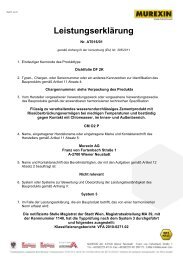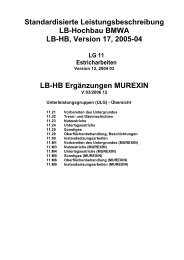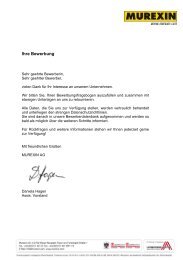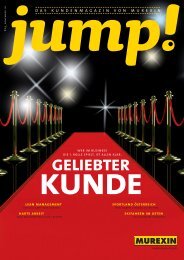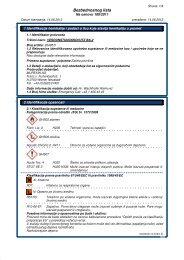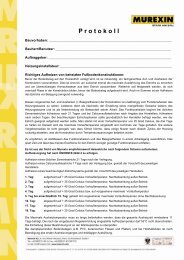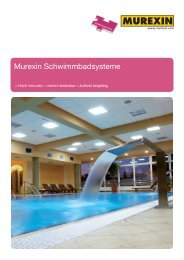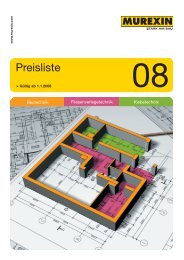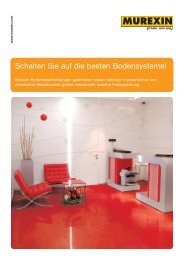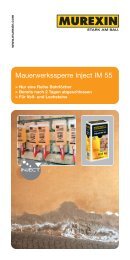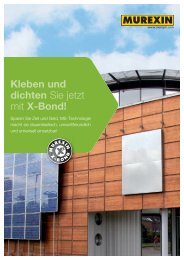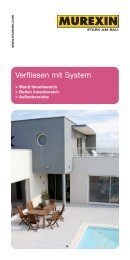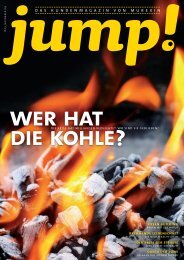IMPRÄGNIERSIEGEL IS 75_ GB - Murexin
IMPRÄGNIERSIEGEL IS 75_ GB - Murexin
IMPRÄGNIERSIEGEL IS 75_ GB - Murexin
You also want an ePaper? Increase the reach of your titles
YUMPU automatically turns print PDFs into web optimized ePapers that Google loves.
36.0.8<br />
Safety data sheet<br />
according to 1907/2006/EC, Article 31<br />
Page 1/8<br />
Printing date 19.04.2013 Version number 2<br />
Revision: 19.04.2013<br />
* 1 Identification of the substance/mixture and of the company/undertaking<br />
1.1 Product identifier<br />
Trade name <strong>IMPRÄGNIERSIEGEL</strong> <strong>IS</strong> <strong>75</strong><br />
1.2 Relevant identified uses of the substance or mixture and uses advised against -<br />
Application of the substance / the preparation Wood-preservative impregnation<br />
1.3 Details of the supplier of the safety data sheet<br />
Manufacturer/Supplier:<br />
MUREXIN AG<br />
Franz v. Furtenbachstr. 1<br />
A-2700 Wiener Neustadt<br />
Tel.: +43 (0)2622/27401<br />
Informing department: r.wachlhofer@murexin.com<br />
1.4 Emergency telephone number:<br />
UK National poisons Emergency number.: +44 (0) 870 600 6266<br />
* 2 Hazards identification<br />
2.1 Classification of the substance or mixture<br />
Classification according to Regulation (EC) No 1272/2008<br />
GHS02 flame<br />
Flam. Liq. 3 H226 Flammable liquid and vapour.<br />
Muta. 1B<br />
Carc. 1B<br />
GHS08 health hazard<br />
H340 May cause genetic defects.<br />
H350 May cause cancer.<br />
Classification according to Directive 67/548/EEC or Directive 1999/45/EC<br />
R10-66-67: Flammable. Repeated exposure may cause skin dryness or cracking. Vapours may<br />
cause drowsiness and dizziness.<br />
Information concerning particular hazards for human and environment:<br />
The product has to be labelled due to the calculation procedure of the "General Classification<br />
guideline for preparations of the EU" in the latest valid version.<br />
At long or repeated contact with skin it may cause dermatitis due to the degreasing effect of the<br />
solvent.<br />
Has a narcotizing effect.<br />
Classification system:<br />
The classification is in line with current EC lists. It is expanded, however, by information from<br />
technical literature and by information furnished by supplier companies.<br />
2.2 Label elements<br />
Labelling according to EU guidelines:<br />
The product has been classified and labelled in accordance with EC Directives.<br />
Hazard-determining components of labelling:<br />
2-butanone oxime<br />
cobalt bis(2-ethylhexanoate)<br />
Risk phrases:<br />
10 Flammable.<br />
66 Repeated exposure may cause skin dryness or cracking.<br />
67 Vapours may cause drowsiness and dizziness.<br />
(Contd. on page 2)<br />
<strong>GB</strong>
36.0.8<br />
Safety data sheet<br />
according to 1907/2006/EC, Article 31<br />
Page 2/8<br />
Printing date 19.04.2013 Version number 2<br />
Revision: 19.04.2013<br />
Trade name <strong>IMPRÄGNIERSIEGEL</strong> <strong>IS</strong> <strong>75</strong><br />
(Contd. of page 1)<br />
Safety phrases:<br />
2 Keep out of the reach of children.<br />
23 Do not breathe gas/fumes/vapour/spray (appropriate wording to be specified by the<br />
manufacturer).<br />
24 Avoid contact with skin.<br />
38 In case of insufficient ventilation, wear suitable respiratory equipment.<br />
51 Use only in well-ventilated areas.<br />
Additional information:<br />
EUH066 Repeated exposure may cause skin dryness or cracking.<br />
2.3 Other hazards<br />
Results of PBT and vPvB assessment<br />
PBT: Not applicable.<br />
vPvB: Not applicable.<br />
* 3 Composition/information on ingredients<br />
3.2 Chemical characterization: Mixtures<br />
Description: Mixture consisting of the following components.<br />
Dangerous components:<br />
CAS: 64742-48-9<br />
EC number: 918-481-9<br />
Reg.nr.: 01-2119457273-39-xxxx<br />
CAS: 64742-48-9<br />
EINECS: 265-150-3<br />
CAS: 64742-47-8<br />
EINECS: 265-149-8<br />
CAS: 34590-94-8<br />
EINECS: 252-104-2<br />
CAS: 112-07-2<br />
EINECS: 203-933-3<br />
CAS: 64742-95-6<br />
EINECS: 265-199-0<br />
CAS: 162627-17-0<br />
EC number: 605-296-0<br />
N AP HT HA ( E RDÖL) , MI T W AS S ER ST O F F<br />
BEHANDELTE SCHWERE<br />
Xn R65<br />
R66<br />
Asp. Tox. 1, H304<br />
10-25%<br />
Naphtha (petroleum), hydrotreated heavy<br />
5-10%<br />
Xn R65<br />
Flam. Liq. 3, H226<br />
Muta. 1B, H340; Carc. 1B, H350; Asp. Tox. 1,<br />
H304<br />
Distillates (petroleum), hydrotreated light<br />
2.5-5%<br />
Xn R65<br />
Asp. Tox. 1, H304<br />
(2-methoxymethylethoxy)propanol<br />
2.5-5%<br />
substance with a Community workplace exposure limit<br />
2-butoxyethyl acetate<br />
< 2.5%<br />
Xn R20/21<br />
Acute Tox. 4, H312; Acute Tox. 4, H332<br />
Solvent naphtha (petroleum), light arom.<br />
0.5-1.0%<br />
N R51/53<br />
R66-67<br />
Carc. Cat. 2, Muta. Cat. 2<br />
Muta. 1B, H340; Carc. 1B, H350; Asp. Tox. 1,<br />
H304<br />
F e t t s ä u r e n , C 1 8 - u n g e s ä t t i g t . , D i m e r e , 0.5-1.0%<br />
R e a k t i o n s p r o d u k t e m i t N , N - D i m e t h y l - 1 , 3 -<br />
Propanediamin<br />
Xi R43<br />
Skin Sens. 1, H317<br />
(Contd. on page 3)<br />
<strong>GB</strong>
36.0.8<br />
Safety data sheet<br />
according to 1907/2006/EC, Article 31<br />
Page 3/8<br />
Printing date 19.04.2013 Version number 2<br />
Revision: 19.04.2013<br />
Trade name <strong>IMPRÄGNIERSIEGEL</strong> <strong>IS</strong> <strong>75</strong><br />
CAS: 136-52-7<br />
EINECS: 205-250-6<br />
CAS: 96-29-7<br />
EINECS: 202-496-6<br />
cobalt bis(2-ethylhexanoate)<br />
Xn R22<br />
Xi R43<br />
Acute Tox. 4, H302; Skin Sens. 1, H317<br />
2-butanone oxime<br />
Xn R21-40<br />
Xi R41<br />
Xi R43<br />
Carc. Cat. 3<br />
Carc. 2, H351<br />
Eye Dam. 1, H318<br />
Acute Tox. 4, H312; Skin Sens. 1, H317<br />
Additional information<br />
For the wording of the listed risk phrases refer to section 16 "List of relevant R phrases:".<br />
(Contd. of page 2)<br />
0.5-1.0%<br />
0.5-1.0%<br />
* 4 First aid measures<br />
4.1 Description of first aid measures<br />
After inhalation Supply fresh air; consult doctor in case of symptoms.<br />
After skin contact Instantly wash with water and soap and rinse thoroughly.<br />
After eye contact<br />
Rinse opened eye for several minutes under running water. If symptoms persist, consult doctor.<br />
After swallowing<br />
Rinse out mouth and then drink plenty of water.<br />
Do not induce vomiting; instantly call for medical help.<br />
4.2 Most important symptoms and effects, both acute and delayed<br />
No further relevant information available.<br />
4.3 Indication of any immediate medical attention and special treatment needed<br />
No further relevant information available.<br />
* 5 Firefighting measures<br />
5.1 Extinguishing media<br />
Suitable extinguishing agents<br />
CO2, extinguishing powder or water jet. Fight larger fires with water jet or alcohol-resistant foam.<br />
For safety reasons unsuitable extinguishing agents Water with a full water jet.<br />
5.2 Special hazards arising from the substance or mixture Can form explosive gas-air mixtures.<br />
5.3 Advice for firefighters<br />
Protective equipment: Put on breathing apparatus.<br />
Additional information<br />
Cool endangered containers with water spray jet.<br />
Dispose of fire debris and contaminated fire fighting water in accordance with official regulations.<br />
* 6 Accidental release measures<br />
6.1 Personal precautions, protective equipment and emergency procedures<br />
Wear protective clothing.<br />
6.2 Environmental precautions:<br />
Do not allow product to reach sewage system or water bodies.<br />
Inform respective authorities in case product reaches water or sewage system.<br />
6.3 Methods and material for containment and cleaning up:<br />
Absorb with liquid-binding material (sand, diatomite, acid binders, universal binders, sawdust).<br />
Ensure adequate ventilation.<br />
6.4 Reference to other sections<br />
See Section 7 for information on safe handling<br />
(Contd. on page 4)<br />
<strong>GB</strong>
36.0.8<br />
Safety data sheet<br />
according to 1907/2006/EC, Article 31<br />
Page 4/8<br />
Printing date 19.04.2013 Version number 2<br />
Revision: 19.04.2013<br />
Trade name <strong>IMPRÄGNIERSIEGEL</strong> <strong>IS</strong> <strong>75</strong><br />
See Section 8 for information on personal protection equipment.<br />
See Section 13 for information on disposal.<br />
(Contd. of page 3)<br />
* 7 Handling and storage<br />
7.1 Precautions for safe handling<br />
Keep containers tightly sealed.<br />
Ensure good ventilation/exhaustion at the workplace.<br />
Prevent formation of aerosols.<br />
Information about protection against explosions and fires:<br />
Keep ignition sources away - Do not smoke.<br />
Fumes can combine with air to form an explosive mixture.<br />
Protect against electrostatic charges.<br />
7.2 Conditions for safe storage, including any incompatibilities<br />
Storage<br />
Requirements to be met by storerooms and containers: Store only in the original container.<br />
Information about storage in one common storage facility:<br />
Do not store together with oxidizing and acidic materials.<br />
Do not store together with alkalis (caustic solutions).<br />
Further information about storage conditions:<br />
Store in cool, dry conditions in well sealed containers.<br />
Keep container tightly sealed.<br />
7.3 Specific end use(s) No further relevant information available.<br />
* 8 Exposure controls/personal protection<br />
Additional information about design of technical systems: No further data; see item 7.<br />
8.1 Control parameters<br />
Components with critical values that require monitoring at the workplace:<br />
34590-94-8 (2-methoxymethylethoxy)propanol<br />
WEL Long-term value: 308 mg/m³, 50 ppm<br />
Sk<br />
112-07-2 2-butoxyethyl acetate<br />
WEL Short-term value: 332 mg/m³, 50 ppm<br />
Long-term value: 133 mg/m³, 20 ppm<br />
Sk<br />
Additional information: The lists that were valid during the compilation were used as basis.<br />
8.2 Exposure controls<br />
Personal protective equipment<br />
General protective and hygienic measures<br />
Keep away from foodstuffs, beverages and food.<br />
Instantly remove any soiled and impregnated garments.<br />
Wash hands during breaks and at the end of the work.<br />
Breathing equipment:<br />
In case of brief exposure or low pollution use breathing filter apparatus. In case of intensive or<br />
longer exposure use breathing apparatus that is independent of circulating air.<br />
Protection of hands: Protective gloves.<br />
Material of gloves<br />
The selection of the suitable gloves does not only depend on the material, but also on further marks<br />
of quality and varies from manufacturer to manufacturer. As the product is a preparation of several<br />
substances, the resistance of the glove material can not be calculated in advance and has therefore<br />
to be checked prior to the application.<br />
(Contd. on page 5)<br />
<strong>GB</strong>
36.0.8<br />
Safety data sheet<br />
according to 1907/2006/EC, Article 31<br />
Page 5/8<br />
Printing date 19.04.2013 Version number 2<br />
Revision: 19.04.2013<br />
Trade name <strong>IMPRÄGNIERSIEGEL</strong> <strong>IS</strong> <strong>75</strong><br />
(Contd. of page 4)<br />
Penetration time of glove material<br />
The exact break trough time has to be found out by the manufacturer of the protective gloves and<br />
has to be observed.<br />
Eye protection: Tightly sealed safety glasses.<br />
Body protection: Protective work clothing.<br />
* 9 Physical and chemical properties<br />
9.1 Information on basic physical and chemical properties<br />
General Information<br />
Appearance:<br />
Form:<br />
Fluid<br />
Colour:<br />
Yellowish<br />
Smell:<br />
Odourless<br />
pH-value:<br />
Not determined.<br />
Change in condition<br />
Melting point/Melting range: Not determined<br />
Boiling point/Boiling range: Not determined<br />
Flash point: 46 °C<br />
Ignition temperature: 200 °C<br />
Self-inflammability:<br />
Danger of explosion:<br />
Density at 20 °C<br />
Solubility in / Miscibility with<br />
Water:<br />
Product is not selfigniting.<br />
Product is not explosive. However, formation of explosive air/<br />
steam mixtures is possible.<br />
0.9 g/cm³<br />
immiscible<br />
Viscosity:<br />
kinematic at 20 °C: 33 s (DIN 53211/4)<br />
9.2 Other information No further relevant information available.<br />
* 10 Stability and reactivity<br />
10.1 Reactivity<br />
10.2 Chemical stability<br />
Conditions to be avoided: No decomposition if used according to specifications.<br />
10.3 Possibility of hazardous reactions No dangerous reactions known<br />
10.4 Conditions to avoid No further relevant information available.<br />
10.5 Incompatible materials: No further relevant information available.<br />
10.6 Hazardous decomposition products: None<br />
* 11 Toxicological information<br />
11.1 Information on toxicological effects<br />
Acute toxicity:<br />
LD/LC50 values that are relevant for classification:<br />
64742-48-9 NAPHTHA (ERDÖL), MIT WASSERSTOFF BEHANDELTE SCHWERE<br />
Oral LD50 >2000 mg/kg (rat)<br />
Dermal LD50 >2000 mg/kg (rabbit)<br />
(Contd. on page 6)<br />
<strong>GB</strong>
36.0.8<br />
Safety data sheet<br />
according to 1907/2006/EC, Article 31<br />
Page 6/8<br />
Printing date 19.04.2013 Version number 2<br />
Revision: 19.04.2013<br />
Trade name <strong>IMPRÄGNIERSIEGEL</strong> <strong>IS</strong> <strong>75</strong><br />
(Contd. of page 5)<br />
Primary irritant effect:<br />
on the skin: No irritant effect.<br />
on the eye: No irritant effect.<br />
Additional toxicological information:<br />
The product shows the following dangers according to the calculation method of the General EC<br />
Classification Guidelines for Preparations as issued in the latest version:<br />
* 12 Ecological information<br />
12.1 Toxicity<br />
Aquatic toxicity:<br />
64742-48-9 NAPHTHA (ERDÖL), MIT WASSERSTOFF BEHANDELTE SCHWERE<br />
IC 50 >100 mg/l (Pseudokirchneriella subcapitata (Alge))<br />
LC50 >100 mg/l (Oncorhynchus mykiss (Regenbogenforelle))<br />
12.2 Persistence and degradability No further relevant information available.<br />
12.3 Bioaccumulative potential No further relevant information available.<br />
12.4 Mobility in soil No further relevant information available.<br />
Additional ecological information:<br />
General notes:<br />
Water hazard class (Germany) 1 (Self-assessment): slightly hazardous for water.<br />
Do not allow undiluted product or large quantities of it to reach ground water, water bodies or<br />
sewage system.<br />
12.5 Results of PBT and vPvB assessment<br />
PBT: Not applicable.<br />
vPvB: Not applicable.<br />
12.6 Other adverse effects No further relevant information available.<br />
* 13 Disposal considerations<br />
13.1 Waste treatment methods<br />
Recommendation<br />
Must not be disposed of together with household garbage. Do not allow product to reach sewage<br />
system.<br />
European waste catalogue<br />
08 01 11* waste paint and varnish containing organic solvents or other dangerous substances<br />
Uncleaned packagings:<br />
Recommendation:<br />
Disposal must be made according to official regulations.<br />
Empty contaminated packagings thoroughly. They can be recycled after thorough and proper<br />
cleaning.<br />
* 14 Transport information<br />
14.1 UN-Number<br />
ADR, IMDG, IATA<br />
14.2 UN proper shipping name<br />
ADR<br />
IMDG, IATA<br />
UN1263<br />
1263 PAINT<br />
PAINT<br />
(Contd. on page 7)<br />
<strong>GB</strong>
36.0.8<br />
Safety data sheet<br />
according to 1907/2006/EC, Article 31<br />
Page 7/8<br />
Printing date 19.04.2013 Version number 2<br />
Revision: 19.04.2013<br />
Trade name <strong>IMPRÄGNIERSIEGEL</strong> <strong>IS</strong> <strong>75</strong><br />
14.3 Transport hazard class(es)<br />
ADR, IMDG, IATA<br />
(Contd. of page 6)<br />
Class<br />
3 Flammable liquids.<br />
Label 3<br />
14.4 Packing group<br />
ADR, IMDG, IATA<br />
14.5 Environmental hazards:<br />
Marine pollutant:<br />
14.6 Special precautions for user<br />
Warning: Flammable liquids.<br />
Kemler Number: 30<br />
EMS Number:<br />
F-E,S-E<br />
14.7 Transport in bulk according to Annex II<br />
of MARPOL73/78 and the IBC Code<br />
Transport/Additional information:<br />
III<br />
No<br />
ADR<br />
Limited quantities (LQ)<br />
5L<br />
Transport category 3<br />
Tunnel restriction code<br />
D/E<br />
UN "Model Regulation":<br />
Not applicable.<br />
UN1263, PAINT, 3, III<br />
* 15 Regulatory information<br />
15.2 Chemical safety assessment: A Chemical Safety Assessment has not been carried out.<br />
* 16 Other information<br />
Relevant phrases<br />
H226 Flammable liquid and vapour.<br />
H302 Harmful if swallowed.<br />
H304 May be fatal if swallowed and enters airways.<br />
H312 Harmful in contact with skin.<br />
H317 May cause an allergic skin reaction.<br />
H318 Causes serious eye damage.<br />
H332 Harmful if inhaled.<br />
H340 May cause genetic defects.<br />
H350 May cause cancer.<br />
H351 Suspected of causing cancer.<br />
R20/21 Harmful by inhalation and in contact with skin.<br />
R21 Harmful in contact with skin.<br />
R22 Harmful if swallowed.<br />
R40 Limited evidence of a carcinogenic effect.<br />
R41 Risk of serious damage to eyes.<br />
R43 May cause sensitisation by skin contact.<br />
R51/53 Toxic to aquatic organisms, may cause long-term adverse effects in the aquatic<br />
environment.<br />
R65 Harmful: may cause lung damage if swallowed.<br />
(Contd. on page 8)<br />
<strong>GB</strong>
36.0.8<br />
Safety data sheet<br />
according to 1907/2006/EC, Article 31<br />
Page 8/8<br />
Printing date 19.04.2013 Version number 2<br />
Revision: 19.04.2013<br />
Trade name <strong>IMPRÄGNIERSIEGEL</strong> <strong>IS</strong> <strong>75</strong><br />
R66 Repeated exposure may cause skin dryness or cracking.<br />
R67 Vapours may cause drowsiness and dizziness.<br />
Contact: Hr. Ing. Wachlhofer<br />
* Data compared to the previous version altered.<br />
(Contd. of page 7)<br />
<strong>GB</strong>



